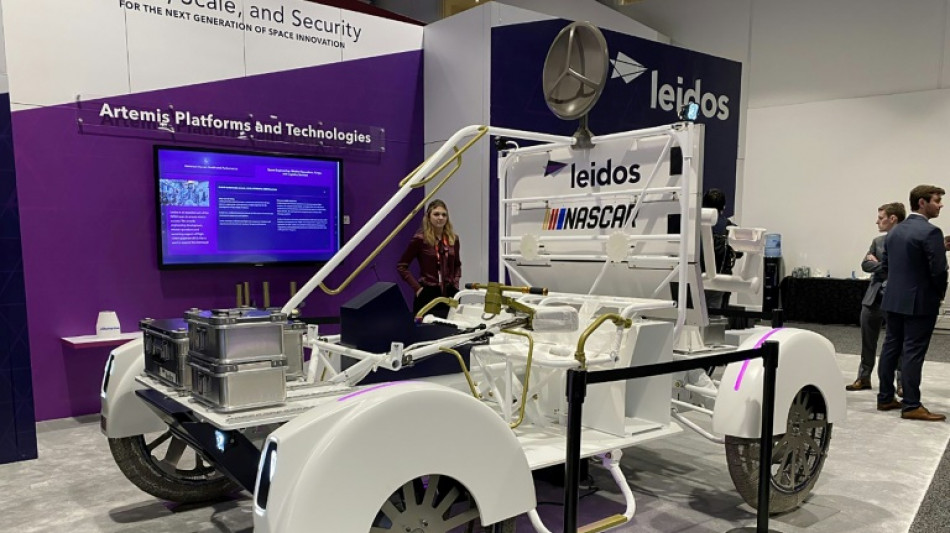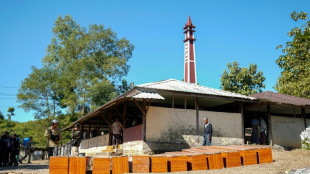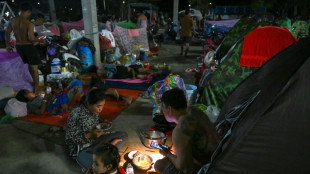
-
 Women sommeliers are cracking male-dominated wine world open
Women sommeliers are cracking male-dominated wine world open
-
Exhibition of Franco-Chinese print master Zao Wou-Ki opens in Hong Kong

-
 Myanmar junta denies killing civilians in hospital strike
Myanmar junta denies killing civilians in hospital strike
-
Why SpaceX IPO plan is generating so much buzz

-
 Thailand continues Cambodia strikes despite Trump truce calls
Thailand continues Cambodia strikes despite Trump truce calls
-
US envoy to meet Zelensky, Europe leaders in Berlin this weekend

-
 North Korea acknowledges its troops cleared mines for Russia
North Korea acknowledges its troops cleared mines for Russia
-
US unseals warrant for tanker seized off Venezuelan coast

-
 Cambodia says Thailand still bombing hours after Trump truce call
Cambodia says Thailand still bombing hours after Trump truce call
-
Machado urges pressure so Maduro understands 'he has to go'

-
 Best Gold Investment Companies in USA Announced (Augusta Precious Metals, Lear Capital, Robinhood IRA and More Ranked)
Best Gold Investment Companies in USA Announced (Augusta Precious Metals, Lear Capital, Robinhood IRA and More Ranked)
-
Leinster stutter before beating Leicester in Champions Cup

-
 World stocks mostly slide, consolidating Fed-fuelled gains
World stocks mostly slide, consolidating Fed-fuelled gains
-
Crypto firm Tether bids for Juventus, is quickly rebuffed

-
 Union sink second-placed Leipzig to climb in Bundesliga
Union sink second-placed Leipzig to climb in Bundesliga
-
US Treasury lifts sanctions on Brazil Supreme Court justice

-
 UK king shares 'good news' that cancer treatment will be reduced in 2026
UK king shares 'good news' that cancer treatment will be reduced in 2026
-
Wembanyama expected to return for Spurs in NBA Cup clash with Thunder

-
 Five takeaways from Luigi Mangione evidence hearings
Five takeaways from Luigi Mangione evidence hearings
-
UK's king shares 'good news' that cancer treatment will be reduced in 2026

-
 Steelers' Watt undergoes surgery to repair collapsed lung
Steelers' Watt undergoes surgery to repair collapsed lung
-
Iran detains Nobel-prize winner in 'brutal' arrest

-
 NBA Cup goes from 'outside the box' idea to smash hit
NBA Cup goes from 'outside the box' idea to smash hit
-
UK health service battles 'super flu' outbreak

-
 Can Venezuela survive US targeting its oil tankers?
Can Venezuela survive US targeting its oil tankers?
-
Democrats release new cache of Epstein photos

-
 Colombia's ELN guerrillas place communities in lockdown citing Trump 'intervention' threats
Colombia's ELN guerrillas place communities in lockdown citing Trump 'intervention' threats
-
'Don't use them': Tanning beds triple skin cancer risk, study finds

-
 Nancy aims to restore Celtic faith with Scottish League Cup final win
Nancy aims to restore Celtic faith with Scottish League Cup final win
-
Argentina fly-half Albornoz signs for Toulon until 2030

-
 Trump says Thailand, Cambodia have agreed to stop border clashes
Trump says Thailand, Cambodia have agreed to stop border clashes
-
Salah in Liverpool squad for Brighton after Slot talks - reports

-
 Marseille coach tips Greenwood as 'potential Ballon d'Or'
Marseille coach tips Greenwood as 'potential Ballon d'Or'
-
Draw marks 'starting gun' toward 2026 World Cup, Vancouver says

-
 Thai PM says asked Trump to press Cambodia on border truce
Thai PM says asked Trump to press Cambodia on border truce
-
Salah admired from afar in his Egypt home village as club tensions swirl

-
 World stocks retrench, consolidating Fed-fuelled gains
World stocks retrench, consolidating Fed-fuelled gains
-
Brazil left calls protests over bid to cut Bolsonaro jail time

-
 Trump attack on Europe migration 'disaster' masks toughening policies
Trump attack on Europe migration 'disaster' masks toughening policies
-
US plan sees Ukraine joining EU in 2027, official tells AFP

-
 'Chilling effect': Israel reforms raise press freedom fears
'Chilling effect': Israel reforms raise press freedom fears
-
Iran frees child bride sentenced to death over husband's killing: activists

-
 No doubting Man City boss Guardiola's passion says Toure
No doubting Man City boss Guardiola's passion says Toure
-
Youthful La Rochelle name teen captain for Champions Cup match in South Africa

-
 World stocks consolidate Fed-fuelled gains
World stocks consolidate Fed-fuelled gains
-
British 'Aga saga' author Joanna Trollope dies aged 82

-
 Man Utd sweat on Africa Cup of Nations trio
Man Utd sweat on Africa Cup of Nations trio
-
EU agrees three-euro small parcel tax to tackle China flood

-
 Taylor Swift breaks down in Eras documentary over Southport attack
Taylor Swift breaks down in Eras documentary over Southport attack
-
Maresca 'relaxed' about Chelsea's rough patch


What will the Artemis Moon base look like?
The next time NASA goes to the Moon, it intends to stay. Under the Artemis program, the US space agency plans to maintain a human presence, for the very first time, on a celestial body other than Earth.
But building a lunar base is no small feat. It will need power generators, vehicles and habitats, and the space industry is racing to meet the technological challenges.
"It's the Super Bowl of engineering," Neal Davis, lead systems engineer for the Lunar Terrain Vehicle at space company Dynetics, told AFP.
Dynetics revealed its prototype design for a Moon rover last month at the Space Symposium in Colorado Springs.
But it probably won't be until later Artemis missions -- 7 onwards -- "where we're starting to look at adding permanent habitations on the surface," said NASA associate administrator Jim Free.
Artemis 3, the first planned landing, won't happen until later this decade, so habitat building wouldn't start before the 2030s.
The base would likely comprise multiple sites, he added, to diversify the targets of scientific exploration and to offer more flexibility for the landings.
- Power and communications -
Despite this distant timeline, companies are already chomping at the bit.
"Step zero is communications," Joe Landon, CEO of Crescent Space, a new subsidiary of Lockheed Martin dedicated to lunar services, told AFP.
"Think about when you move into a new apartment, you've got to hook up your phone and your internet first."
Starting out with a pair of satellites, the company wants to become the Moon's internet and GPS provider.
This would relieve the strain on NASA's Deep Space Network, which threatens to overheat in the face of all the upcoming missions, including private ones.
Landon estimates the value of the lunar market will be "$100 billion over the next 10 years."
Next up: switching on the lights.
Astrobotic, with 220 employees, is one of three companies selected by NASA to develop solar panels.
They need to be placed vertically because at the Moon's south pole -- the intended destination because it has water in the form of ice -- the Sun barely peeps above the horizon.
About 60 feet (18 meters) high, the Astrobotic panels will be connected by cables running several miles (kilometers), said Mike Provenzano, the company's director of lunar surface systems.
The solar arrays will be fixed to vehicles that can run them out to different locations.
- Vehicles -
For its scientific expeditions, NASA has tasked industry with developing an unpressurized -- that is to say, open top -- rover for two people, ready by 2028.
Unlike the Apollo missions' rovers, it will also have to operate autonomously for outings without an astronaut.
This means surviving frigid lunar nights, which can last two weeks, with temperatures dropping to around -280 degrees Fahrenheit (-170 Celsius).
Many companies have made a start.
Lockheed Martin has partnered with General Motors, leaning on the auto giant's expertise in electric and off-road vehicles.
Dynetics, a subsidiary of engineering behemoth Leidos, has joined forces with Nascar.
Its prototype, which will achieve a top speed of nine miles per hour (15 kilometers per hour), includes a robotic arm and metal wheels that are braided like textiles to maximize traction on the sandy surface and deal with any rocks they encounter.
"But at the same time, they actually have a lot of openings to the outside so that they don't collect that sand and carry it with us," Davis said.
Moon dust, or regolith, poses a major challenge because, lacking erosion by water or wind, it is almost as abrasive as glass.
NASA has yet to announce the selected company or companies.
In the longer term, NASA is working with the Japanese space agency JAXA on a pressurized vehicle, in which astronauts won't need to keep their suits on.
- Habitats -
Finally, the crew will need a place to hang up their helmets and call home.
NASA has awarded a $57.2 million contract to the Texas-based company Icon, which specializes in 3D printing, to develop the technology needed to build roads, landing strips on the Moon, and ultimately, dwellings.
The idea is to use lunar soil as a material. Other companies, such as Lockheed Martin, are developing inflatable habitat concepts.
"The beautiful thing is you can land it on the moon and inflate it and now there's a much larger volume for the crew to live in and work in," Kirk Shireman, vice president for the Lockheed Martin Lunar Exploration Campaign, told AFP.
Inside would be bedrooms, a kitchen, a space for scientific instruments, etc. -- all mounted on a frame, so the habitat can be mobile.
The basic concept behind returning to the Moon under Artemis is to help NASA prepare for much more distant missions to Mars.
"Whatever money we have to spend to go develop these systems on the moon, we want those same systems to be applicable to go to Mars," said Shireman.
L.Mason--AMWN

